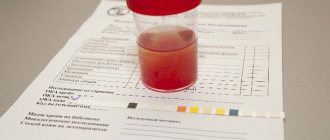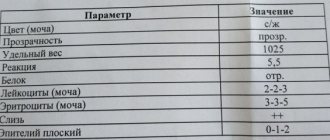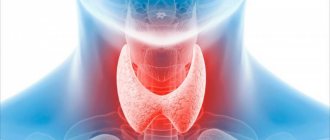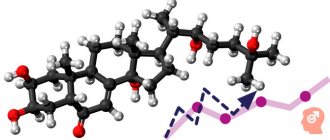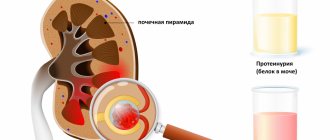A general urine test is a mandatory test for diagnosing various diseases. But sometimes it does not allow making an accurate diagnosis in order to prescribe the correct treatment. In such cases, a urine test according to Nechiporenko is prescribed. It is a microscopic examination. During this process, the number of cylinders, red blood cells and white blood cells in 1 ml of urine is counted using a special counting chamber. This allows you to accurately assess the condition of the urinary system.
Indications for testing
The main indication for prescribing a urine test according to Nechiporenko for adults and children is the detection of deviations in the results obtained after a general urine test. The study can confirm the development of a certain pathology or classify deviations from the norm as random.
Indications for urine analysis according to Nechiporenko are the appearance of symptoms that may indicate the development of serious pathologies. This is, first of all, cloudiness of the urine, as well as a change in its color and smell. The study is also prescribed in the following cases:
- If you experience pain in the lumbar region, which may indicate kidney problems.
- When changing the frequency of urination and the amount of urine.
- If blood is detected in the urine.
- For systemic diseases that increase the risk of renal dysfunction.
- During preventive examinations.
Mandatory tests include urine analysis according to Nechiporenko during pregnancy. It allows you to promptly detect malfunctions in the functioning of the urinary system. Thanks to this, it will be possible to purchase the necessary products at an affordable price to support a woman’s body while bearing a child.
Microscopic examination with quantitative counting of leukocytes, red blood cells and casts in 1 milliliter of urine sediment.
Synonyms Russian
Determination of the amount of blood cells in urine sediment, Nechiporenko’s test.
English synonyms
Urinalysis, Urine test, Urine analysis, UA, Microscopic Examination, Urine.
Research method
Microscopy.
Units
Cells/ml (cells per milliliter), Units/ml (unit per milliliter).
What biomaterial can be used for research?
An average portion of morning urine.
How to properly prepare for research?
- Do not eat spicy, salty foods, or foods that change the color of urine (for example, beets, carrots) for 12 hours before the test.
- Avoid taking diuretics for 48 hours before urine collection (in consultation with your doctor).
General information about the study
Urinalysis according to Nechiporenko allows you to more accurately determine the quantitative content of red blood cells, leukocytes and casts than a general clinical urine test. Both studies are carried out using microscopy, but in the Nechiporenko test, elements are counted per unit volume of liquid, and not by the number of cells or cylinders in the field of view.
Normally, the renal glomeruli do not allow blood cells and albumin to pass through, but in some diseases the renal barrier is damaged, which is reflected in changes in the composition of urine. The presence of a large number of red blood cells in the urine (hematuria) may indicate damage to the glomerulus. It must be taken into account that blood cells in the urine are found in cases of damage, stones, inflammatory diseases or neoplasms at all levels of the urinary tract - blood enters there from the renal pelvis, ureter, bladder or urethra. The renal origin of hematuria is indicated by the identification of red blood cell casts or leached red blood cells.
Normally, leukocytes are present in urine in small quantities. Their content may increase in inflammatory diseases of the urinary system, genitourinary tract infections and some acute inflammatory systemic diseases. Leukocytes are able to penetrate to the site of inflammation through intact tissue. If they are excessively isolated - leukocyturia - it is necessary to conduct a bacteriological examination of urine to clarify the etiology of the disease and prescribe adequate therapy.
In clinical practice, the definition of leukocyturia or hematuria is often used in the differential diagnosis of glomerulonephritis and pyelonephritis.
Casts are protein conglomerates that are produced from cells and cellular detritus when the physicochemical properties of urine change. They form in the renal tubules and take their shape. Epithelial cells of the tubules form epithelial casts; when epithelial cells and leukocytes are destroyed, granular casts appear; wide waxy casts are formed from degenerating granular casts. Their detection indicates severe kidney damage, the development of renal failure and an unfavorable prognosis of the disease. Hyaline casts form from proteins and often indicate proteinuria. Their formation involves the protein Tamm-Horsfall protein, which is normally present in the renal tubules in dissolved form and is important in the immunological protection of the organ from infection. Hyaline casts can also be found in a healthy person after intense physical activity or with minimal pathological changes in the kidneys.
What is the research used for?
- For the diagnosis of acute and chronic inflammatory diseases of the urinary tract (pyelonephritis, glomerulonephritis, cystitis, urethritis).
- To evaluate kidney damage in certain systemic diseases (eg, diabetes mellitus, systemic lupus erythematosus, amyloidosis, vasculitis, and trauma).
- For differential diagnosis of urinary tract diseases.
- To monitor the treatment of diseases of the urinary organs.
When is the study scheduled?
- For symptoms of pathology of the urinary tract (changes in color, smell, transparency and amount of urine, frequency of urination, pain in the lumbar region, lower abdomen, when urinating).
- In case of questionable results or abnormalities in the general urine analysis.
- For systemic diseases with a high risk of damage to kidney function.
- During preventive studies.
- When monitoring the effectiveness of treatment of urinary tract diseases.
What do the results mean?
Reference values
| Component | Reference values |
| Leukocytes | 0 – 2000 cells/ml |
| Red blood cells | 0 - 1000 cells/ml |
| Cylinders: hyaline | 0 - 20 U/ml |
| Cylinders: grained | 0 - 20 U/ml |
| Cylinders: waxy | 0 - 20 U/ml |
| Cylinders: others | 0 - 20 U/ml |
Reasons for the increase in indicators
Red blood cells
- Kidney infarction.
- Glomerulonephritis.
- Urolithiasis disease.
- Hemorrhagic cystitis.
- Tubulointerstitial nephritis.
- Polycystic kidney disease.
- Severe pyelonephritis.
- Kidney injury.
- Kidney tuberculosis.
- Kidney tumor.
- Renal vein thrombosis.
- Benign familial hematuria, benign recurrent hematuria.
- Benign prostatic hypertrophy.
- Hemophilia.
- Congestive heart failure
- Subacute infective endocarditis.
- Systemic lupus erythematosus.
- Urinary tract infection.
- Leukemia, thrombocytopenia.
- Vasculitis.
- Collagenoses.
- Goodpasture's syndrome.
- Malignant hypertension.
- Scurvy (vitamin C deficiency).
Leukocytes
- Acute pyelonephritis.
- Cystitis.
- Glomerulonephritis.
- Nephrotic syndrome.
- Kidney tuberculosis.
- Systemic lupus erythematosus.
- Bladder tumor.
- Appendicitis.
- Acute pancreatitis.
- Fever.
Epithelial casts
- Acute necrosis of the renal tubules (kidney infarction).
- Eclampsia.
- Glomerulonephritis.
- Heavy metal poisoning.
- Tubulointerstitial nephritis.
Hyaline casts
- Nephrotic syndrome and proteinuria.
- Pyelonephritis.
- Intense physical activity.
- Chronic renal failure.
- Glomerulonephritis.
- Congestive heart failure.
- Diabetic nephropathy.
- Malignant hypertension.
- Fever with dehydration, overheating.
- Emotional stress.
Waxy cylinders
- Chronic kidney disease.
- Diabetic nephropathy.
- Amyloidosis of the kidneys.
- Malignant hypertension.
- Kidney transplant rejection.
- Nephrotic syndrome.
- Lipoid nephrosis.
- Paraproteinuria in myeloma.
Grainy cylinders
- Acute renal failure.
- Chronic mercury poisoning.
- Chronic renal failure.
- Glomerulonephritis.
- Malignant hypertension.
- Pyelonephritis.
- Kidney tuberculosis.
- Toxicosis of pregnant women.
- Intense physical activity.
What can influence the result?
- Hematuria sometimes occurs with intense physical exertion or trauma to the urethra with a catheter. Red blood cells can be found in the urine when menstrual fluid or hemorrhoidal bleeding gets into it.
- Drugs that can cause hematuria: alteplase, acetylsalicylic acid, amphotericin B, bacitracin, warfarin, BCG vaccine, danazol, ibuprofen, indomethacin, itraconazole, candesartan, clopidogrel, methenamine, methicillin, mefenamic acid, misoprostol, penicillamine, phenylbu tazon, salicylates, sulfonamides.
- Medicines that reduce hematuria: ascorbic acid, captopril, finasteride, lamotrigine.
Peculiarities
The analysis involves examining urine sediment. To do this, the biomaterial is poured from a sterile container into a test tube and mixed. After this, the vessel is placed in a centrifuge and the sediment is separated. After this, it is carefully examined in a volume of 1 ml in a chamber equipped with a special counter. The obtained data is multiplied by the provided coefficients to correctly reflect the level of structures.
Violations of the rules for urine collection most often lead to unreliable results. The risk of data distortion increases when storing biomaterial in non-sterile containers.
Analysis indicators
Many people are interested not only in how the Nechiporenko urine test is performed, but also in what it shows. Deviation from the norm towards an increase in the number of leukocytes indicates the presence of inflammatory and infectious processes. In this case, to make a diagnosis, an additional test for the presence of pathogenic microorganisms in the urine is prescribed. This will allow you to buy the necessary medications in accordance with the doctor’s recommendations and carry out effective therapy. A small number of white blood cells in the urine indicates normal functioning of the immune system.
Confirmation of a large number of red blood cells in the urine indicates damage to the urinary system. The main function of red blood cells is to transport oxygen through tissues. They should be present in the urine in minimal quantities. Exceeding their permissible amount may indicate the development of serious diseases, in particular the following:
- Tumor processes in the kidneys.
- Kidney tuberculosis.
- Urolithiasis.
- Glomerulonephritis.
- Intoxication of the body.
Also an important indicator of urine analysis according to Nechiporenko is the number of cylinders. They are special casts that occur when protein is present in the urine. This substance, under the influence of an acidic environment, coagulates, forming compressed elements called cylinders. Their number may be insignificant during intense physical activity and emotional stress. But a large number indicates the development of serious pathologies: glomerulonephritis, renal failure, kidney tuberculosis, etc. In addition, exceeding standard indicators may indicate the risks of rejection of a donor kidney.
The norm is considered to be a quantity not exceeding the following values:
- For red blood cells 1000/ml.
- For leukocytes 2000/ml
- For 20/ml cylinders
How to correctly collect a urine test according to Nechiporenko?
You have been prescribed a Nechiporenko test: how to take it correctly? For the study, morning urine is needed - that is, it is collected immediately after waking up. The procedure should be as follows:
- The external genitalia are washed with warm water.
- The first small portion of urine is released into the toilet (the bladder empties just a little!) - it is not suitable for analysis. The subsequent liquid (the average portion of urine) is collected in a container. The last portion of urine is also released into the toilet.
- The resulting biomaterial (about 25-50 ml) is placed in a special sterile container: it can be bought at any pharmacy.
- Within 1.5-2 hours, urine must be delivered to the laboratory. Later, the material will no longer be suitable for research. It is recommended to store urine in the refrigerator before leaving home.
Before the procedure, simple preparation is necessary. The day before urine collection, exclude:
- Overheating of the body - visiting baths, solariums, hot baths.
- Taking anti-inflammatory and antibacterial drugs: ibuprofen, aspirin, indomethacin.
- Products with bright colors that can affect the color of urine - carrots, beets.
- Alcohol, sweets, spicy food.
Before collecting biomaterial, you should not change your drinking regime, that is, drink more or less liquid than usual. During the day before the procedure, you should refrain from consuming excess protein foods. If you are taking diuretics, you should stop taking them two days before collecting the material (you should definitely consult your doctor about discontinuation!).
Important . Urinalysis according to Nechiporenko is not performed for acute inflammation in the urinary system, colpitis and during menstruation. If the patient has undergone medical procedures such as cystoscopy or urography, urine can be collected no earlier than 5-7 days after them.
How to properly collect urine from a child?
Many parents are concerned about the question if their child has been prescribed a urine test according to Nechiporenko: how to collect it, especially if we are talking about a baby?
In children older than one year, the analysis is collected as in adults, except that the “collector” will have to independently control the process of releasing the first portion of urine. It is most convenient to carry out this procedure in the bath. After the child releases the first portion of liquid, it is necessary to place the container so that the middle portion of glass falls into it.
To collect urine from children under one year of age, pharmacies sell special urine collectors. They are transparent bags with a hole and adhesive edges and are suitable for both girls and boys. This urine collector is attached to the baby’s skin in the morning and waits for urination. Once the pouch is full, it is separated from the skin and closed.
Important . When submitting an analysis to the laboratory, it is necessary to warn workers that the biomaterial belongs to an infant, and the container contains all the morning urine (since it is very difficult to release the first portion in this case).
